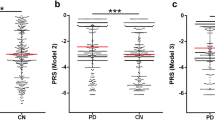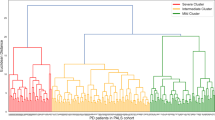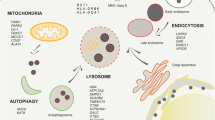Abstract
Parkinson’s disease (PD) is a multi-factorial disorder with high-penetrant mutations accounting for small percentage of PD. Our previous studies demonstrated individual association of genetic variants in folate, xenobiotic, and dopamine metabolic pathways with PD risk. The rational of the study was to develop a risk prediction model for PD using these genetic polymorphisms along with synuclein (SNCA) polymorphism. We have generated additive, multifactor dimensionality reduction (MDR), recursive partitioning (RP), and artificial neural network (ANN) models using 21 SNPs as inputs and disease outcome as output. The clinical utility of all these models was assessed by plotting receiver operating characteristics curves where in area under the curve (AUC) was used as an index of diagnostic utility of the model. The additive model was the simplest and exhibited an AUC of 0.72. The MDR model showed significant gene–gene interactions between SNCA, DRD4VNTR, and DRD2A polymorphisms. The RP model showed SHMT C1420T as important determinant of PD risk. This variant allele was found to be protective and this protection was nullified by MTRR A66G. Inheritance of SHMT wild allele and SNCA intronic polymorphism was shown to increase the risk of PD. The ANN model showed higher diagnostic utility (AUC = 0.86) compared to all the models and was able to explain 56.6 % cases of sporadic PD. To conclude, the ANN model developed using SNPs in folate, xenobiotic, and dopamine pathways along with SNCA has higher clinical utility in predicting PD risk compared to other models.




Similar content being viewed by others
References
Engelender S, Kaminsky Z, Guo X, Sharp AH, Amaravi RK, Kleiderlein JJ et al (1999) Synphilin-1 associates with alpha-synuclein and promotes the formation of cytosolic inclusions. Nat Genet 22(1):110–114
Riess O, Jakes R, Krüger R (1998) Genetic dissection of familial Parkinson’s disease. Mol Med Today 4(10):438–444
Götz ME, Freyberger A, Riederer P (1990) Oxidative stress: a role in the pathogenesis of Parkinson’s disease. J Neural Transm Suppl 29:241–249
Rodriguez MC, Obeso JA, Olanow CW (1998) Subthalamic nucleus-mediated excitotoxicity in Parkinson’s disease: a target for neuroprotection. Ann Neurol 44(3 Suppl 1):S175–S188
Miller DB, O’Callaghan JP (2015) Biomarkers of Parkinson’s disease: present and future. Metabolism 64(3 Suppl 1):S40–S46
Kumudini N, Uma A, Naushad SM, Mridula R, Borgohain R, Kutala VK (2014) Association of seven functional polymorphisms of one-carbon metabolic pathway with total plasma homocysteine levels and susceptibility to Parkinson’s disease among South Indians. Neurosci Lett 568:1–5
Kumudini N, Uma A, Devi YP, Naushad SM, Mridula R, Borgohain R et al (2013) Impact of COMT H108L, MAOB int 13 A > G and DRD2 haplotype on the susceptibility to Parkinson’s disease in South Indian subjects. Indian J Biochem Biophys 50(5):436–441
Kumudini N, Uma A, Devi YP, Naushad SM, Mridula R, Borgohain R et al (2014) Association of Parkinson’s disease with altered serum levels of lead and transition metals among South Indian subjects. Indian J Biochem Biophys 51(2):121–126
Wang D, Zhai JX, Zhang LM, Liu DW (2014) Null genotype of GSTT1 contributes to increased Parkinson’s disease risk in Caucasians: evidence from a meta-analysis. Mol Biol Rep 41(11):7423–7430
Yu L, Xu P, He X, Hu F, Lin Z, Zhu M et al (2010) SNP rs7684318 of the alpha-synuclein gene is associated with Parkinson’s disease in the Han Chinese population. Brain Res 1346:262–265
Mizuta I, Satake W, Nakabayashi Y, Ito C, Suzuki S, Momose Y et al (2006) Multiple candidate gene analysis identifies alpha-synuclein as a susceptibility gene for sporadic Parkinson’s disease. Hum Mol Genet 15(7):1151–1158
Kiyohara C, Miyake Y, Koyanagi M, Fujimoto T, Shirasawa S, Tanaka K et al (2011) Genetic polymorphisms involved in dopaminergic neurotransmission and risk for Parkinson’s disease in a Japanese population. BMC Neurol 11:89
Hariharan M, Polat K, Sindhu R (2014) A new hybrid intelligent system for accurate detection of Parkinson’s disease. Comput Methods Progr Biomed 113(3):904–913
Palumbo B, Fravolini ML, Nuvoli S, Spanu A, Paulus KS, Schillaci O et al (2010) Comparison of two neural network classifiers in the differential diagnosis of essential tremor and Parkinson’s disease by (123)I-FP-CIT brain SPECT. Eur J Nucl Med Mol Imaging 37(11):2146–2153
Hancock DB, Martin ER, Vance JM, Scott WK (2008) Nitric oxide synthase genes and their interactions with environmental factors in Parkinson’s disease. Neurogenetics 4:249–262
Hsieh AR, Hsiao CL, Chang SW, Wang HM, Fann CS (2011) On the use of multifactor dimensionality reduction (MDR) and classification and regression tree (CART) to identify haplotype-haplotype interactions in genetic studies. Genomics 97(2):77–85
Ritchie MD, White BC, Parker JS, Hahn LW, Moore JH (2003) Optimization of neural network architecture using genetic programming improves detection and modeling of gene-gene interactions in studies of human diseases. BMC Bioinform 4:28
Deng S, Deng X, Yuan L, Song Z, Yang Z, Xiong W et al (2014) Genetic analysis of SNCA coding mutation in Chinese Han patients with Parkinson disease. Acta Neurol Belg 115(3):267–271
Singh M, Khan AJ, Shah PP, Shukla R, Khanna VK, Parmar D (2008) Polymorphism in environment responsive genes and association with Parkinson disease. Mol Cell Biochem 312(1–2):131–138
De Palma G, Dick FD, Calzetti S, Scott NW, Prescott GJ, Osborne A et al (2010) A case-control study of Parkinson’s disease and tobacco use: gene-tobacco interactions. Mov Disord 25(7):912–919
Grevle L, Güzey C, Hadidi H, Brennersted R, Idle JR, Aasly J (2000) Allelic association between the DRD2 TaqI A polymorphism and Parkinson’s disease. Mov Disord 15(6):1070–1074
Tan EK, Tan Y, Chai A, Tan C, Shen H, Lum SY et al (2003) Dopamine D2 receptor TaqIA and TaqIB polymorphisms in Parkinson’s disease. Mov Disord 18(5):593–595
Smythies JR (1984) The role of the one-carbon cycle in neuropsychiatric disease. Biol Psychiatry 19(5):755–758
Fong CS, Shyu HY, Shieh JC, Fu YP, Chin TY, Wang HW et al (2011) Association of MTHFR, MTR, and MTRR polymorphisms with Parkinson’s disease among ethnic Chinese in Taiwan. Clin Chim Acta 412(3–4):332–338
García-Minguillán CJ, Fernandez-Ballart JD, Ceruelo S, Ríos L, Bueno O, Berrocal-Zaragoza MI et al (2014) Riboflavin status modifies the effects of methylenetetrahydrofolate reductase (MTHFR) and methionine synthase reductase (MTRR) polymorphisms on homocysteine. Genes Nutr 9(6):435
Cheng H, Gomes-Trolin C, Aquilonius SM, Steinberg A, Löfberg C, Ekblom J et al (1997) Levels of l-methionine S-adenosyltransferase activity in erythrocytes and concentrations of S-adenosylmethionine and S-adenosylhomocysteine in whole blood of patients with Parkinson’s disease. Exp Neurol 145(2 Pt 1):580–585
Duan W, Ladenheim B, Cutler RG, Kruman II, Cadet JL, Mattson MP (2002) Dietary folate deficiency and elevated homocysteine levels endanger dopaminergic neurons in models of Parkinson’s disease. J Neurochem 80(1):101–110
Fu TF, Hunt S, Schirch V, Safo MK, Chen BH (2005) Properties of human and rabbit cytosolic serine hydroxymethyltransferase are changed by single nucleotide polymorphic mutations. Arch Biochem Biophys 442(1):92–101
Tan EK, Tan C, Fook-Chong SM, Lum SY, Chai A, Chung H et al (2003) Dose-dependent protective effect of coffee, tea, and smoking in Parkinson’s disease: a study in ethnic Chinese. J Neurol Sci 216(1):163–167
Chen JF, Xu K, Petzer JP, Staal R, Xu YH, Beilstein M et al (2001) Neuroprotection by caffeine and A(2A) adenosine receptor inactivation in a model of Parkinson’s disease. J Neurosci 21(10):143
Wilson WW, Shapiro LP, Bradner JM, Caudle WM (2014) Developmental exposure to the organochlorine insecticide endosulfan damages the nigrostriatal dopamine system in male offspring. Neurotoxicology 44:279–287
Acknowledgments
We thank all the subjects who participated in this study.
Author information
Authors and Affiliations
Corresponding author
Rights and permissions
About this article
Cite this article
Kumudini, N., Naushad, S.M., Alex Stanley, B. et al. Comparative analysis of four disease prediction models of Parkinson’s disease. Mol Cell Biochem 411, 127–134 (2016). https://doi.org/10.1007/s11010-015-2574-0
Received:
Accepted:
Published:
Issue Date:
DOI: https://doi.org/10.1007/s11010-015-2574-0




